Exotic, but established
Native
Grapholita Treitschke (Tortricidae: Olethreutinae: Grapholitini)
At one point, Grapholita contained approximately 160 described species distributed worldwide. As currently circumscribed, it contains about 40 species after many of its former species were transferred to different genera following a molecular phylogeny of Grapholitini (Hu et al. 2023Hu et al. 2023:
Hu, G.-L., Brown, J.W., Heikkilä, M., Aarvik, L., Mutanen, M. 2023. Molecular phylogeny, divergence time, biogeography and trends in host plant usage in the agriculturally important tortricid tribe Grapholitini (Lepidoptera: Tortricidae: Olethreutinae). Cladistics. 39(5): 359-381.).
Adults are small (FWLFWL:
forewing length; the distance from the base of the forewing to the apex, including fringe 4.0-6.5 mm) and brown, usually with white markings and a well-defined ocellusocellus:
4.0-6.5 mm) and brown, usually with white markings and a well-defined ocellusocellus:
forewing pattern element - an ovoid region anterior to the tornus; adult head - a simple insect "eye" located dorsal to the compound eye 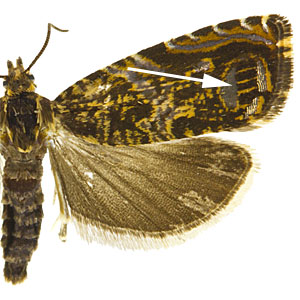 . Many species have bright white costal strigulaecostal strigulae:
. Many species have bright white costal strigulaecostal strigulae:
small, usually pale, semirectangular marks along the costa 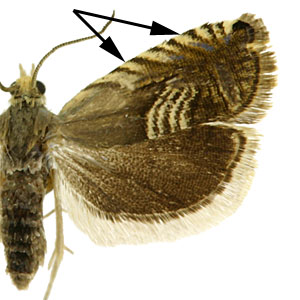 and one or more pairs of dorsaldorsal:
and one or more pairs of dorsaldorsal:
upper, to the top, on the back 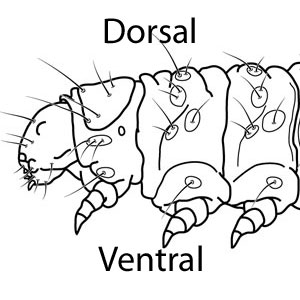 strigulae. Male genitalia are characterized by the absence of an uncusuncus:
strigulae. Male genitalia are characterized by the absence of an uncusuncus:
a sclerotized process which is fused to the posterodorsal margin of tergum IX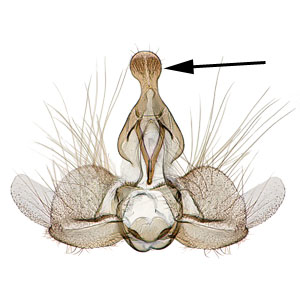 and sociisocii:
and sociisocii:
a pair of lightly sclerotized setose lobes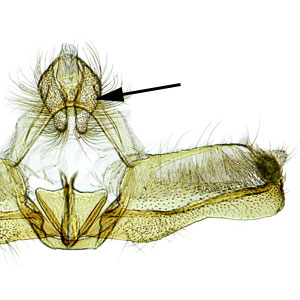 , and a well-defined, densely setosesetose:
, and a well-defined, densely setosesetose:
covered with setae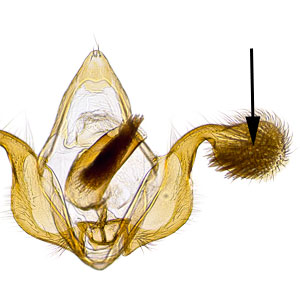 cuculluscucullus:
cuculluscucullus:
the distal portion of the male valva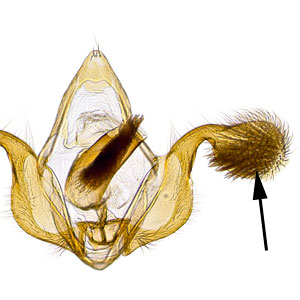 . Female genitalia are characterized by a short ductus bursaeductus bursae:
. Female genitalia are characterized by a short ductus bursaeductus bursae:
a membranous tube connecting the ostium bursae to the corpus bursae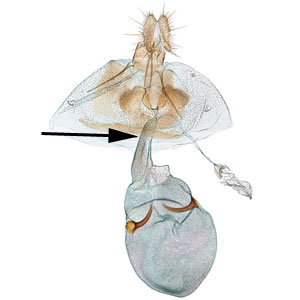 and two thorn-like signasigna:
and two thorn-like signasigna:
plural of "signum"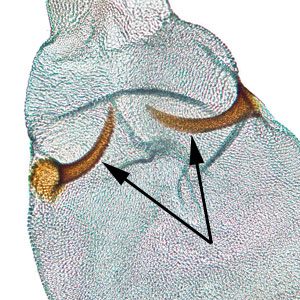 in the corpus bursaecorpus bursae:
in the corpus bursaecorpus bursae:
a dilated membranous sac at the anterior end of the bursa copulatrix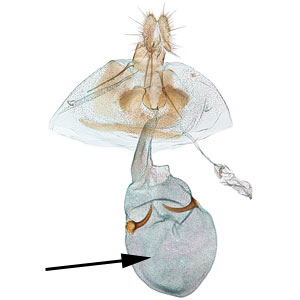 in many species.
in many species.
Most of the economically important species such as oriental fruit moth (A. molesta), cherry fruit worm (A. packardi), lesser apple worm (A. prunivora), and plum fruit moth (A. funebrana) were transferred to Aspila when the former subgenus of Grapholita was raised to full genus status (Hu et al. 2023Hu et al. 2023:
Hu, G.-L., Brown, J.W., Heikkilä, M., Aarvik, L., Mutanen, M. 2023. Molecular phylogeny, divergence time, biogeography and trends in host plant usage in the agriculturally important tortricid tribe Grapholitini (Lepidoptera: Tortricidae: Olethreutinae). Cladistics. 39(5): 359-381.). The species remaining in Grapholita generally are not major economic pests, although larvae of G. delineana can occasionally be a pest of hemp, hops, and marijuana.
The white to reddish larvae resemble those of other internally feeding olethreutines, such as Cydia and Aspila, but larvae of Grapholita and Aspila can usually be separated by the anal fork, which is present in many Grapholita and Aspila and absent in most Cydia.
Exotic, but established species
Grapholita delineana
Native species
Grapholita interstinctana
View full screen host table here
Additional photos and distribution maps for species in the United States and Canada are available at Moth Photographers Group.